Deeper economic integration and a growing middle class attracts manufacturing investment in the ASEAN region in 2015. However, a lack of political will to eliminate barriers to intra-regional trade could also dent the region’s appeal as a manufacturing hub.

As the end-2015 deadline for economic integration approaches, the ASEAN region will be a major focus for manufacturing investment. In pursuit of a single market and production base, the ten ASEAN member states intend to transform the region into an EU-style economic area characterized by free flow of goods, services, investments, and (skilled) labor.
Through the establishment of the ASEAN Economic Community (AEC), businesses can fully tap into the region’s potential as an integrated and single investment destination. ASEAN is already a major manufacturing hub. According to a report by the Economist Intelligence Unit (EIU), ASEAN’s economy makes up 3.2% of the global GDP, while accounting for 4.3% of global manufacturing output.
The figures reveal that manufacturing investments across ASEAN have historically been export-oriented as a result of the region’s relatively cheap labor costs. Looking ahead, however, the focus of manufacturing investment is likely to shift towards the Southeast Asian market and the region’s surging demand.
ASEAN has outpaced the rest of the world in GDP growth per capita since the late 1970s and remains one of the fastest growing regions in the world with average annual real gains of more than 5%.
Taken as a whole, ASEAN is already the seventh largest economy in the world. With fast economic development, ASEAN will become a pivotal consumer market in the near future. Indonesia alone—ASEAN’s largest economy—is projected to double its consuming class (comprised of middle-class and affluent users) to more than 140 million people by 2020.
According to these projections by the Boston Consulting Group, eight to nine million people will add to the consuming class each year during that period: the biggest increase anywhere in the world outside of India or China and a tremendous opportunity for manufacturing investments.
The implementation of the AEC will allow manufacturing investors to capitalize on the depicted trends in consumption by creating a single market that reaches a total of 600 million people. In addition, ASEAN as a single production base can facilitate economies of scale and greater specialization, contributing to an enhanced productivity across the region.
The possibility to integrate supply chains and obtain duty-free access to the markets of all ten ASEAN member states will lure manufacturers to the region. However, it is vital to see the elimination of tariffs in context: average tariff rates in the original six member states (Indonesia, Malaysia, the Philippines, Brunei, Singapore, and Thailand) have been virtually zero since 2010. Non-tariff barriers remain the greatest stumbling block for trade liberalisation across ASEAN.
While the AEC adds to the region’s value as base of operations for foreign manufacturers, much will depend on ASEAN’s ability to effectively remove obstacles to intra-regional trade. There remains the risk that some ASEAN member states will fail to mobilise the political will necessary to eliminate the non-tariff barriers.
sourche: http://globalriskinsights.com/2015/01/asean-may-attract-new-investor-attention-in-2015/
Δεν υπάρχουν σχόλια:
Δημοσίευση σχολίου